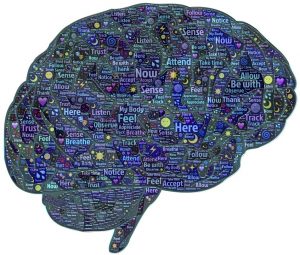Do you sometimes detect a bad vibe, or a good one? This intuition could be more than fantasy. Ultrasound is all around us, even if we can’t hear it with our physical ears.
A scientific study from July 2016 shows that these ultrasonic sound waves have a direct impact on neural activity. Could a continuous pulse of undetected, high frequencies be exciting, or suppressing stuff that goes in on in your head, experience or body?
“We can call to the Beloved from our hearts, but we need to be able to listen for the answer.”
Georgi
 We can all recognize the sound of the dog whistle – not by its tone, but by the immediate response of our furry friends whose ears have a different range of sound from us. Yet, just because sound is not consciously heard, does that mean that we’re not affected? Could it be that clairaudience and the often decipherable logic of certain thoughts are the mind’s method to give representation to resonance that is within perception, but beneath the threshold of waking consciousness? Imagine the unanchored thought: “I am fearful”, in entering a bank. Is this thought the result of the firing of neurons according to the subtle vibration created through generations of chemical stress release in one location?
We can all recognize the sound of the dog whistle – not by its tone, but by the immediate response of our furry friends whose ears have a different range of sound from us. Yet, just because sound is not consciously heard, does that mean that we’re not affected? Could it be that clairaudience and the often decipherable logic of certain thoughts are the mind’s method to give representation to resonance that is within perception, but beneath the threshold of waking consciousness? Imagine the unanchored thought: “I am fearful”, in entering a bank. Is this thought the result of the firing of neurons according to the subtle vibration created through generations of chemical stress release in one location?
The ignorance in assuming that sounds outside of our human audible range are not effecting us, perhaps manifesting as intuition, inner voices, or even threatening voices today belies scientific evidence. Ultrasound not only effects our brains – it can explode brain tumors or activate neurons. So what’s the vibe? Are we ready to trust what we intuit over the more vulgar voices we are bombarded with on a daily basis through TV and internet? Perhaps even more fundamentally, are we ready to trust the silence behind it all?
Who shall I say is calling?
Ultrasound is acoustic (sound) energy in the form of waves having a frequency above the human hearing range. The highest frequency that the human ear can detect is approximately 20 thousand cycles per second (20,000 Hz). This is where the sonic range ends, and where the ultrasonic range begins. Ultrasound is used in electronic, navigational, industrial, and security applications. It is also used in medicine to view internal organs of the body. Today, it is being pioneered to impact brain function, showing that a little inaudible sound can be a big deal in the nanoscale dimension of our neural networks.
A Technion study from June 2016 reveals a mechanism for accurate and individualized control of brain activity using ultrasonic waves: ultrasound’s waveform pattern dramatically affects interaction with neurons, and consequently, certain ultrasound patterns will have a different effect on different types of neurons.
This approach may complement or even partially replace existing brain treatments, which require surgical insertion of electrodes through the skull and are therefore inherently more risky. The ability to affect nerve cells using ultrasound waves has recently seen dramatic developments, including a demonstration of the ability to create artificial (phantom) sensations in human subjects by direct brain stimulation. However, since these are highly complex systems and phenomena, much is still unknown about them, particularly with regard to the mechanisms impact neural networks.
“A new ability to engineer ultrasound patterns that will specifically activate neuron populations.”
 In a study just published in the journal eNeuro, the Technion team puts forward a unifying new theoretical foundation that explains a wide range of experimental findings in the field. Their study surprisingly concludes that the ultrasound’s waveform pattern dramatically affects its interaction with neurons, and consequently certain ultrasound patterns will have a different effect on different types of neurons. The framework they introduce also makes it possible to predict the outcome of complex interactions in realistic brain neural networks which are composed of various types of neurons.
In a study just published in the journal eNeuro, the Technion team puts forward a unifying new theoretical foundation that explains a wide range of experimental findings in the field. Their study surprisingly concludes that the ultrasound’s waveform pattern dramatically affects its interaction with neurons, and consequently certain ultrasound patterns will have a different effect on different types of neurons. The framework they introduce also makes it possible to predict the outcome of complex interactions in realistic brain neural networks which are composed of various types of neurons.
The study is based on NICE – a bio-physical model that the research group developed to explain the effect of ultrasound waves on brain cells. According to NICE, when the ultrasonic waves interact with a cell, the cellular membrane experiences nano-scale vibrations which lead to electrical charge accumulation on the membrane: the longer the vibrations continue, the more charge builds up in the membrane. Eventually, enough charge builds up so that an action potential is generated. The group now shows that when the ultrasonic wave is activated in short pulses, this will cause selective excitation of inhibitory cells, with the net result of suppression of the neural network activity. This is the first explanation for this suppression phenomenon, which was recently observed experimentally by researchers at Harvard University.
“Right now, the brain is still something of a closed box. Ultrasound could help to pry open that box.”
The new study may lead to breakthroughs in the field of non-invasive medical treatment of neurological diseases. “Right now, the brain is still something of a closed box,” says Prof. Shoham. “Ultrasound could help to pry open that box. Now, for example, for the first time at the Technion and in cooperation with InSightec Ltd. and Prof. Itamar Kahn of the Rappaport Faculty of Medicine, we are using functional MRI technology to examine the effect of ultrasound on brain activity, so that we can both excite and monitor it without recourse to electrodes and other invasive means.”




